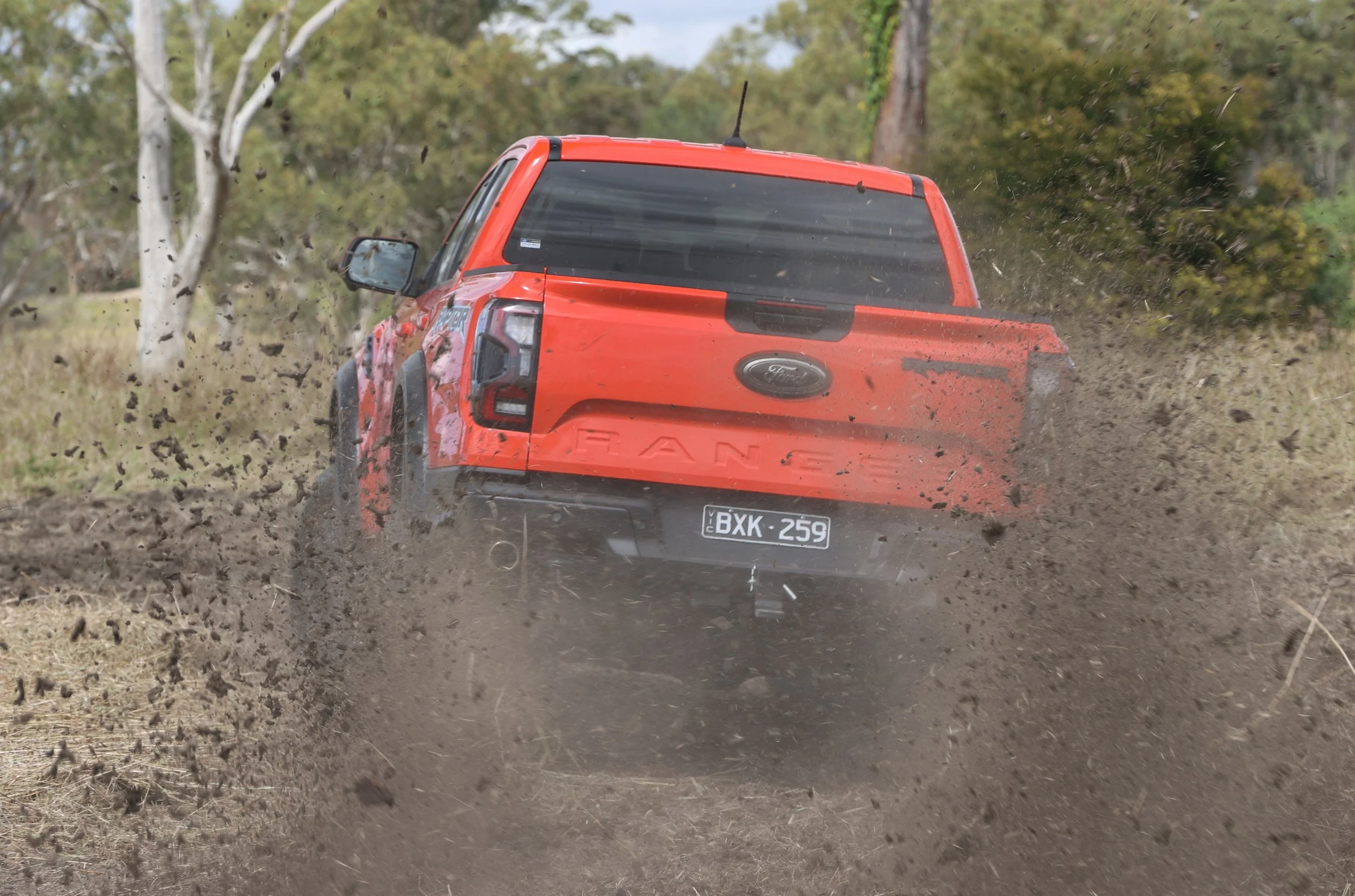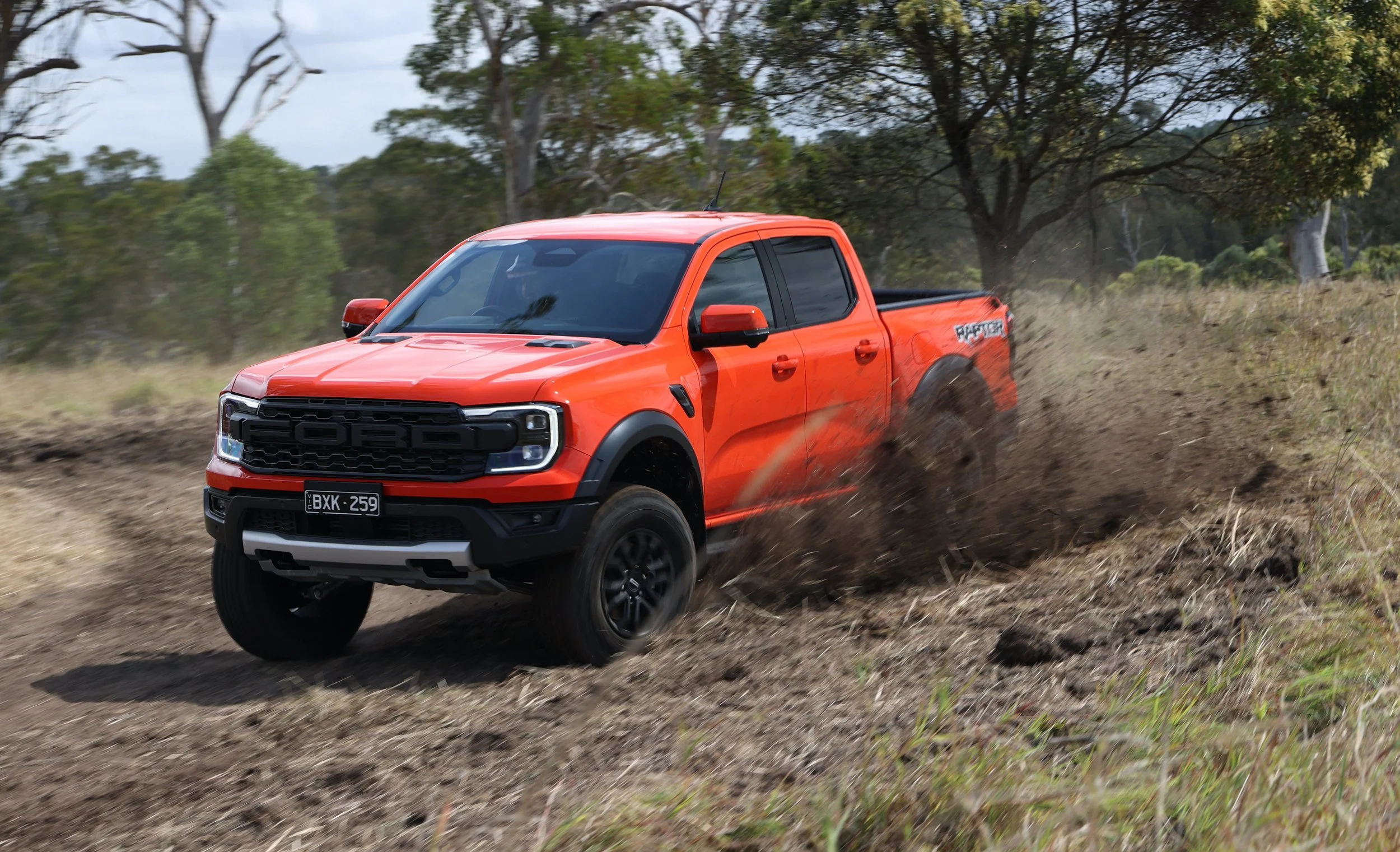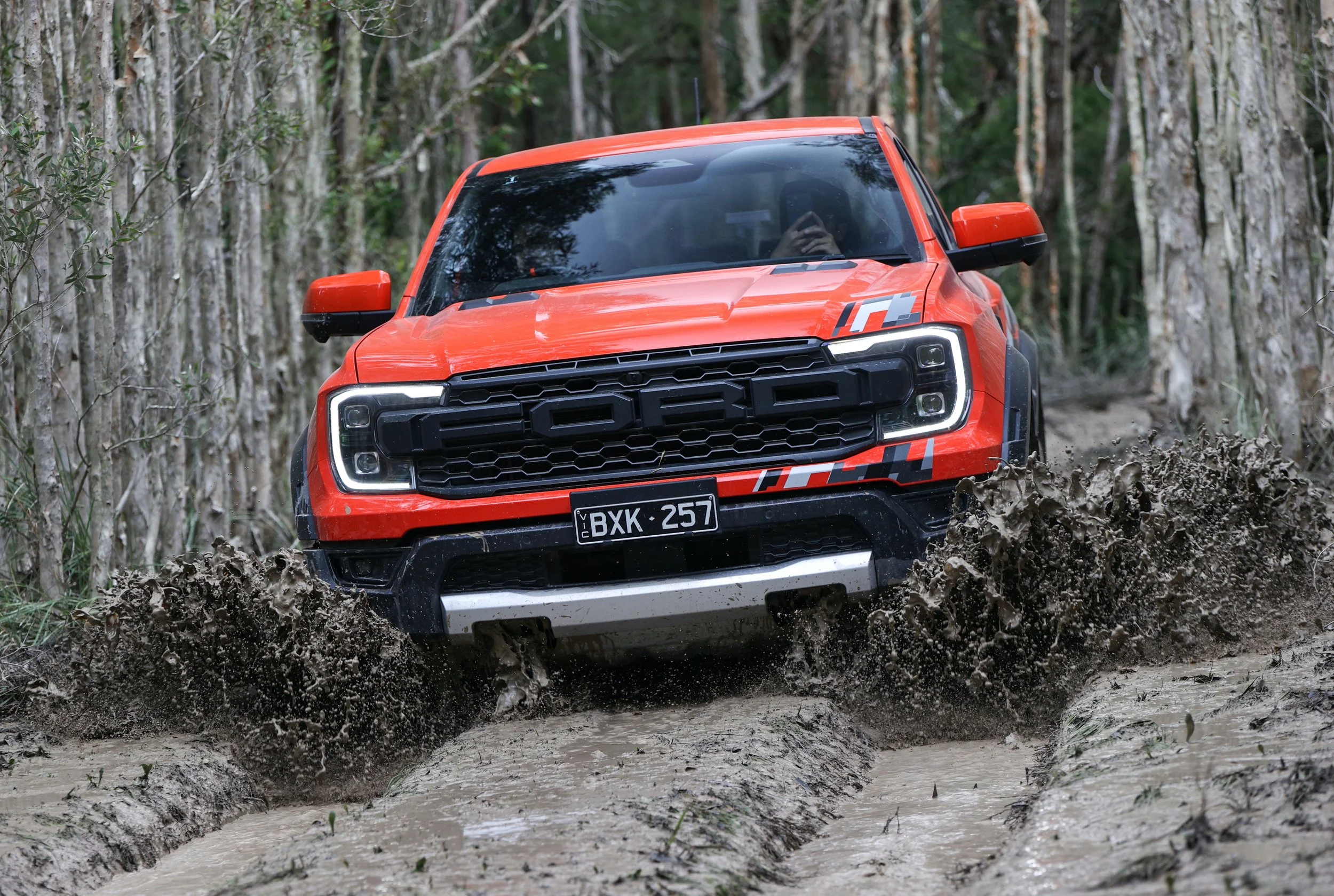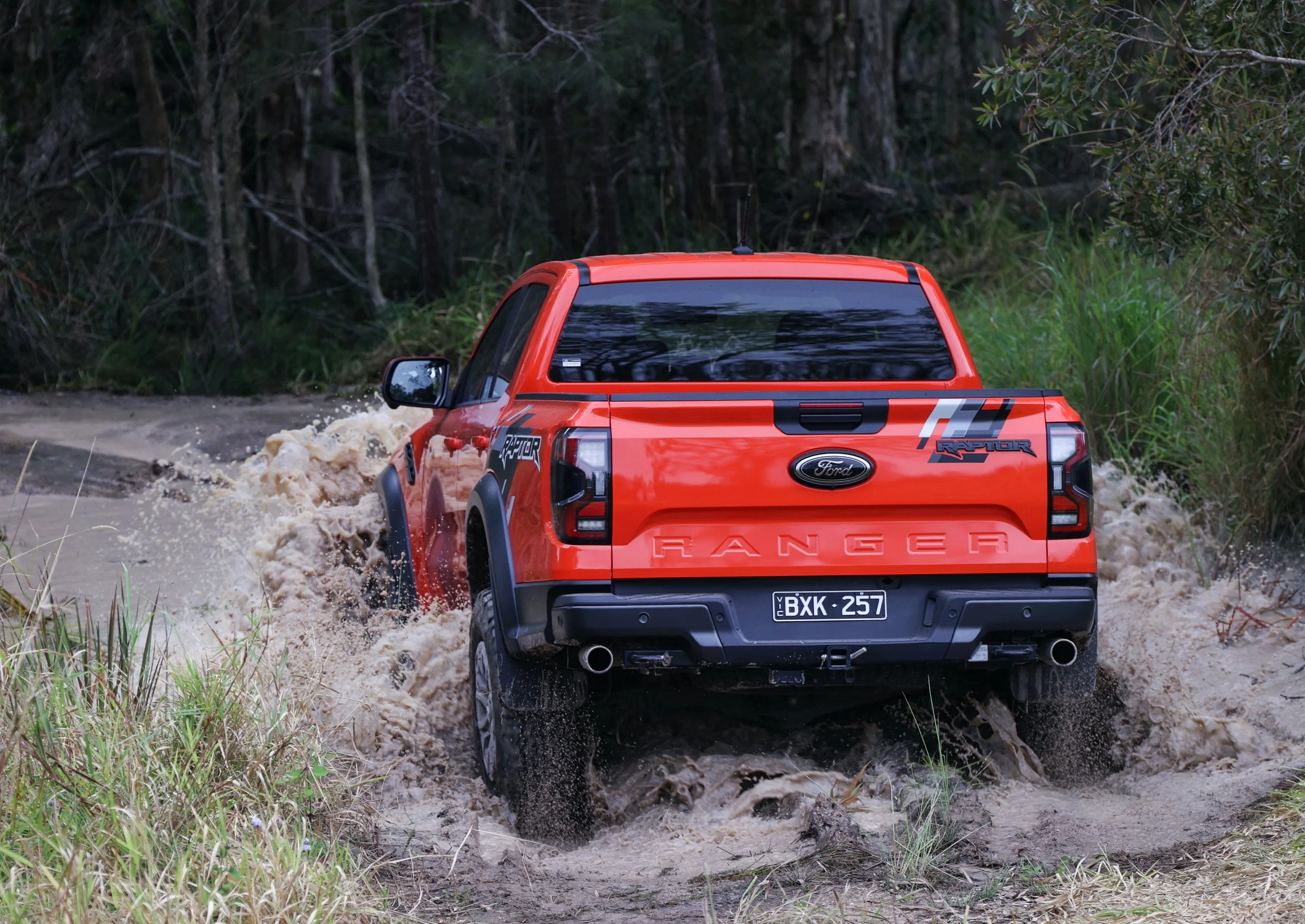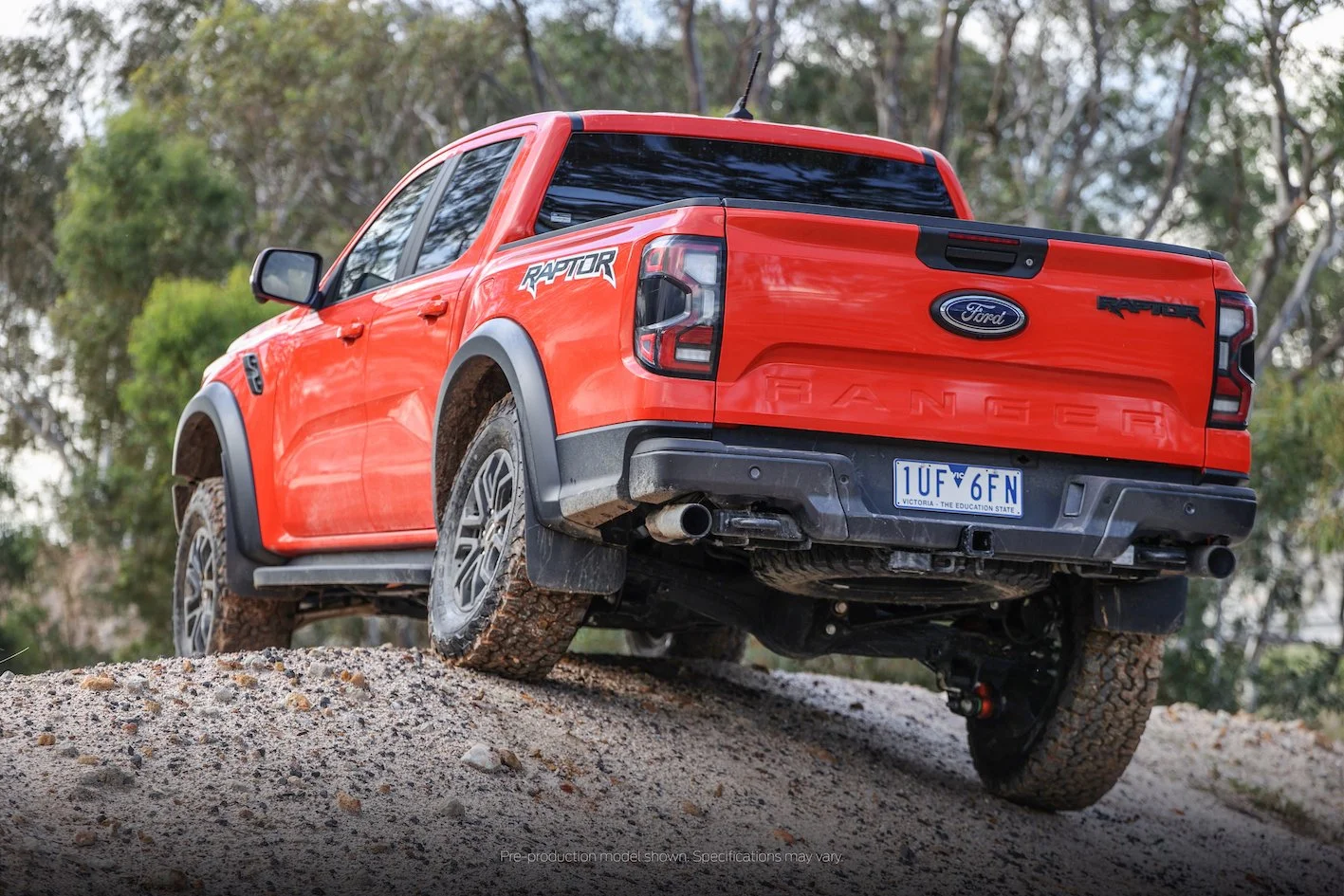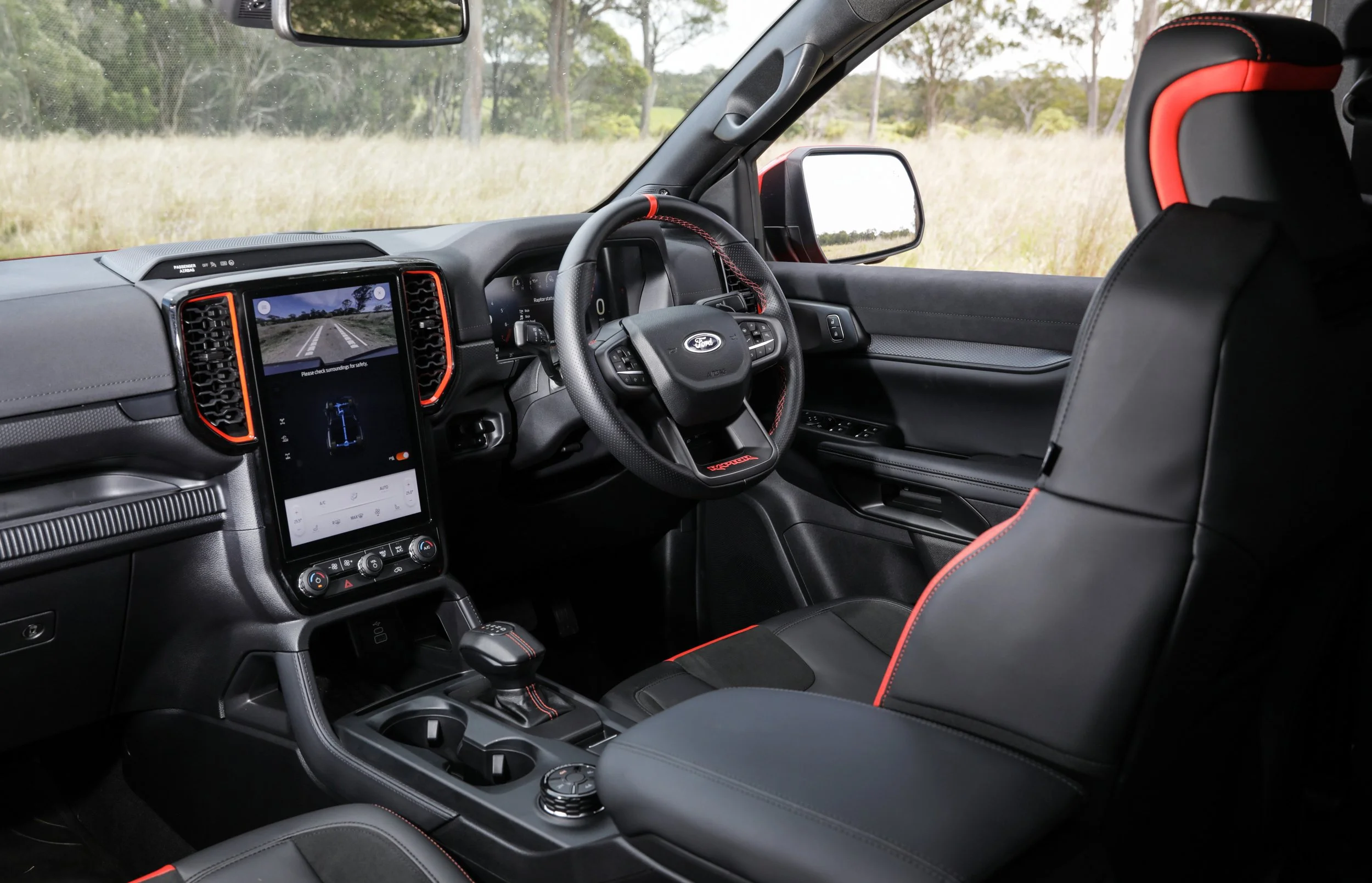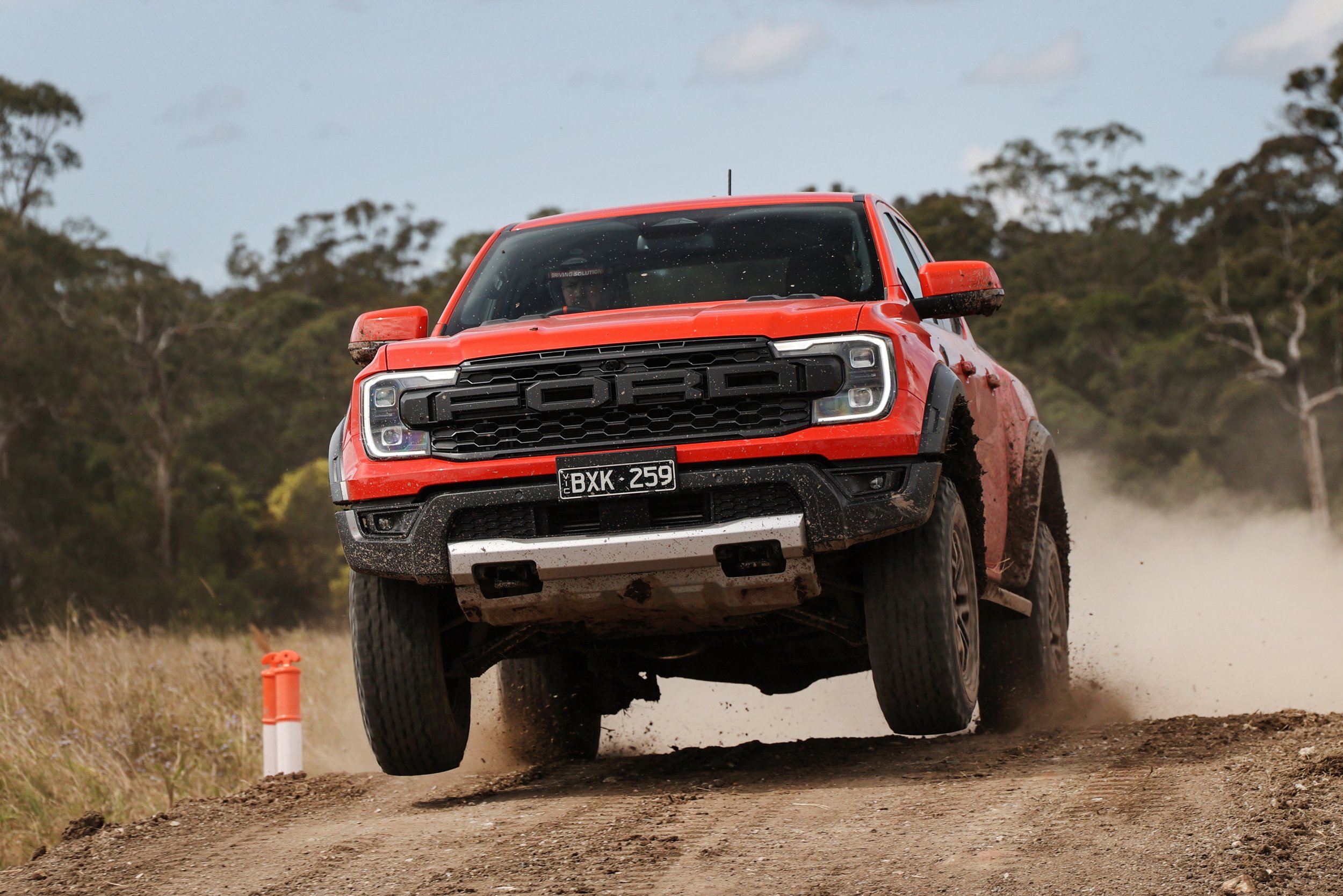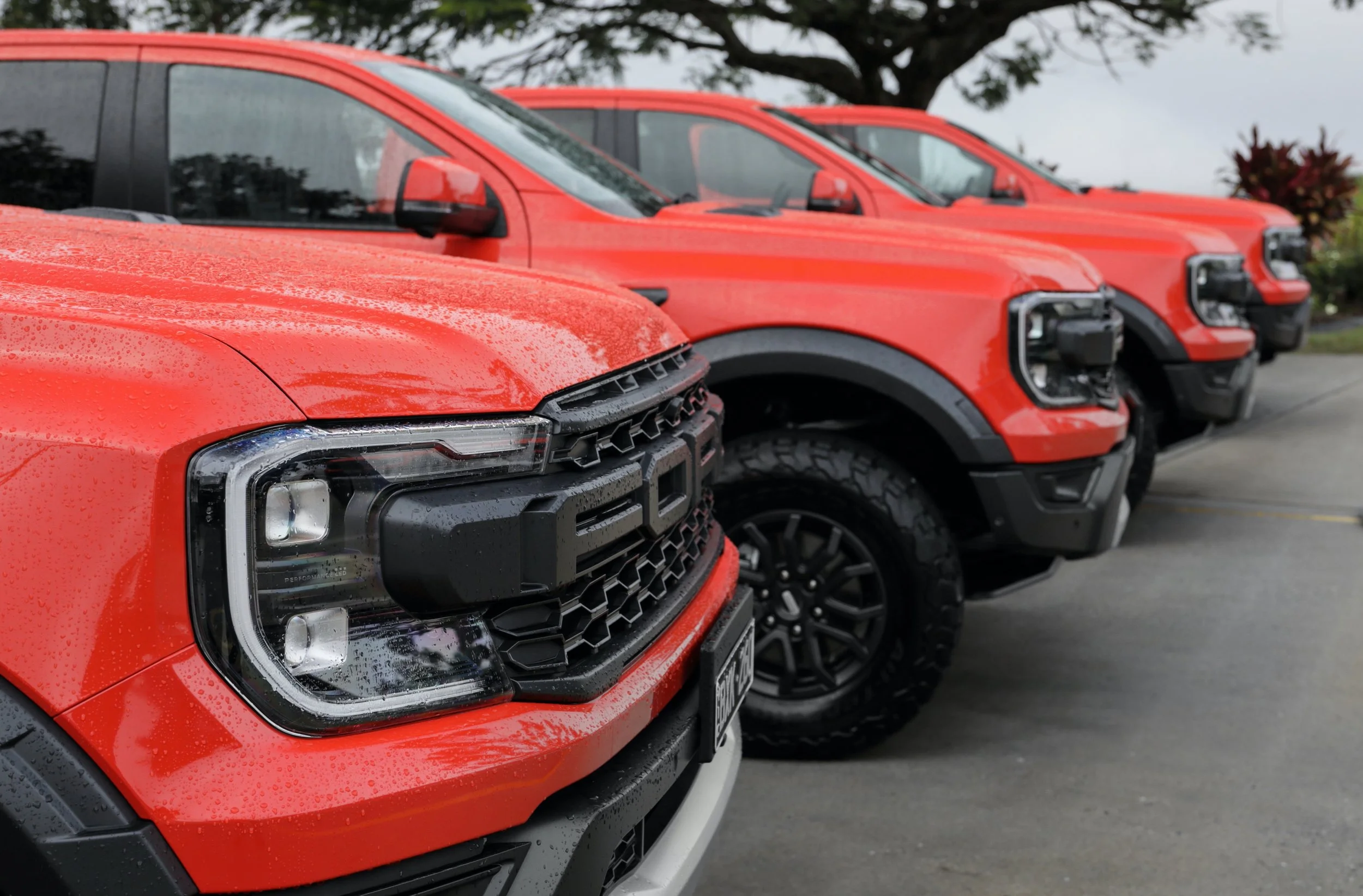Ford Ranger Raptor first drive review: Burn notice
/Ford takes the customer call for more power very, very seriously. With all the expected consequences.
“KEEP looking to the corner … that’s it … now, hook it into the inside … wait… wait… little dip on the throttle … that’s it … now flat out.”
I’m first driver today on a course that’s felt a dose of overnight rain; for me, it’s a selection of mainly short firm sections offering reasonable to total grip interspersed with rutted, boggy corners with none at all.
The chunky tyres are overwhelmed; the black ick packs the treads. By halfway around I might as well be on slicks. All the power in the world and no way to effectively lay it down.
The one section that allows real speed is gravel-topped; only a couple of hundred metres, gradually heading into a tightening right then a fishhook left that demands huge, hard out braking if you’re going to be brave. I’m determined to so the speedo is showing something north of 100kmh before the pedal hit.
James, the good-natured guy who laid out this evil genius arena, is sitting in with me, barking helpful commands and says I’m getting this right.
We’ve started in the old Raptor before shifting to the new. The Mark 1’s four-cylinder diesel is slower on throttle command but is strong-willed. The best line in the fastest section asks for it to smash across craters. It’s darty and nervous.
The replacement, with a six-cylinder petrol offering twice the power and massively more accelerative force? Well, yes, those factors alone make it a total handful of roaring crazy, and then some; tail out here, four-wheel-drift there; bastard understeer, too, if you get into the slurry too hot.
Patience is a virtue. Bugger that. I don’t have the time. But I’m loving the massive increase in thrust, the better braking feel, the sharper steering. It’s not a beast easily tamed, but bloody hell is this one heck of a ride. You cannot help but grin and laugh on getting it right, swear when screwing up. So addictive.
It becomes very apparent that best tactic to keep decent pace is to create new apexes; hook the inside wheels into the long, dry grass and hope there’s nothing too large and firm to hit. James doesn’t seem adverse to me doing this – within reason. There might, just might, be a big rock in there. Plus the snakes. I don’t care too much about running one of those over. But I wouldn’t want to step out onto one should I managed to plant the Raptor into a place beyond recovery.
So, best stick – in a literal, more than actual, sense – to the track, more or less. Even doing this, there’s one off-camber left, around a tree, that I mess up twice in my three laps. Just a touch too much throttle too soon and the Raptor half-spins both times. Back out, hard right, plant boot, onward. For the rest of the day, this place is known as Kiwi corner.
No Raptor run is complete without a jump. It’s modest, but still … I so want to get lift off. But that’s tricky as it’s straight after a slow in mud section. On last attempt, I finally sense all four feet scrabbling nothing but air. It’s nothing Ken Block would be proud off, yet I’ll take it.
And that’s it for the high-speed stuff. One lap on the old, three in the new – the last being a bonus – and the next opportunity to give this performance rig total absolute beans will have to be on home turf. I cannot wait, frankly. I’m astounded how it simply dismisses divots, craters and bumps, not matter what angle or speed they’re struck.
It’s an A-grade weapon. And needs to be. Raptor’s premium placement is built upon it delivering ultimate tough ability to a level above the predecessor’s talent. Hence why it has undergone so much more development in Australia’s Outback than the Mark 1.
For a full two years, home for the development programme was a sun-baked testing ground in South Australia; nothing but sand, dirt, rocks and extreme heat.
A much tougher spot that the media launch location, a high-brow Queensland vineyard sited in a lush green belt, 30 minutes from Brisbane. Mt Cotton’s Sirromet vineyard is a nice place, but this 266-hectare property is a walk in the park compared to the conditions at Ford’s playground, 2000kms away.
Still, the property owners have allowed Ford reign to convert the forested areas and an abandoned golf course into a playground that delivers decent off-roading.
After the fast charge experience we’re into low-speed mud-plugging through a section of swamp, of which it also makes light work. I thought it would as we’d covered the exact same course the day before in the new Everest – that experience still for now subject to embargo, sorry – which, with the latest V6 turbodiesel, has 100Nm extra torque but is also heavier and has a more streetwise tyre. As much as you wouldn’t want to walk through the muck, that both models could consistently attack and overcome every obstacle, plus the absence of vehicles kitted with recovery equipment, suggested our hosts had been careful in their risk level.
We also left the property for a 40-minute road drive, though gave only limited insight into the dynamic aptitude; just enough to show there’s definite talent here. The locale being so close to suburbia meant our tour was through terrain in which the local authority determined maximum speeds should, whenever corners were involved, be as low as 40kmh and no higher than 70kmh. The few 100kmh sections were all straight and smooth. A different kind of torture test for this $89,990 machine.
Reminder about how well-prepared Raptor is for real extremes came from a pre-drive briefing covering the design, with word from team leader Max Wolff, and engineering, where Dave Burn did the talking. The latter’s official job title is ‘Ford performance and customisation chief programme engineer’ – he laughingly suggests it’s easier just to say he’s the guy who “owns the toyshop.”
Whereas the preceding Raptor was a late life inclusion – remember, it was only on sale for four years – the new one’s development kicked off in unison with the regular Ranger’s. First decision was to sign up the engine, plucked from the Ford F150, then everything else was engineered to the meet that huge power boost, everything run from Australia, with more development also there, save for brief overseas programmes to see how it handled extreme cold. For that Ranger went to North America and to the Southern Hemisphere Proving Ground, aka the Snow Farm, between Queenstown and Wanaka.
Ford suggest the big improvements wrought regular Ranger – the widened footprint and lengthened wheelbase – were done to suit Raptor, which also goes further with additional reinforcement for the c-pillar, tray and shock mounts. It has a unique spare tyre carrier plus high-strength steel bash plates for the underbody. What carried over from the previous vehicle? Basically, not a lot other than the BF Goodrich tyres.
There’s a lot more tech. This is one tricked-up truck. Cameras to cover off blind spots, displays that shows steering angle, an inclinometer and all that good dirt-friendly stuff, ‘Trail Control’ - which Ford describes as “like cruise control for off-roading” – and seven drive modes, more dedicated to off-seal than on-road, layer atop the move to a permanent four-wheel-drive system with lockable front and rear diffs.
Positives from the 292kW/583Nm 3.0-litre dual turbo petrol V6 are easily picked. It’s a maniac powerplant; firing with a flare of revs and demonstrating redline eagerness you’ll never see from Ranger’s other 3.0-litre V6, the diesel.
Also unsurprising but set to be sobering for ownership experience nonetheless is that it brings American drinking habits, going top shelf – 95 octane or better for full power (it’ll take 91, but won’t have the same kick).
Ford ‘s testing suggests it won’t achieve better than 11.5 litres per 100km in overall optimal. That’s by total coincidence the same economy claimed for the previous turbo six Burn was involved with, the Falcon XR6 Turbo. Just to remind, the previous Raptor sat at 8.1L and the current Wildtrak puts it back at 8.4L/100km.
Reality is that any owner will have to expect to be refuelling much more regularly than with a diesel. That official economy and the brand-cited overall range of mid-600kms’ kilometres’ range are big asks. There’s good reason why the favoured after-market involver is said to be developing a larger fuel tank option to the standard 88-litre one.
The examples used exclusively for mud-plugging were averaging around 19 litres per 100km. I didn’t check the two dedicated to the high-speed run but they likely would have been the same.
The one I had on the open road run, during which a lead car sometimes kept us running under the posted absolutes, was drawing down at 15L/100km. It had already used a quarter of a tank in other hands that day, the trip computer when I sat behind the wheel suggested I’d have 283kms’ driving left.
The new is also well in the naughty corner for emissions. The 292 grams of CO2 per kilometre output assessed under our WLTP3 protocol (Ford Aus says 262, but that’s with the outdated NEDC formula) means there’s already a $5175 Clean Car penalty, but Clean Car Standard enacting on January 1 is going to being a price rise. If that second-level legislation plays out fully, this rig will heft a $10,000 penalty in 2025.
As previously, the race truck suspension, brakes and wheels demand reductions in payload (by 244kg, to 753kg) and towing maximums (by 1000kg, to 2.5 tonnes). It’s not as bad as before, but still enough to site it as a shirker against regular Ranger.
Notwithstanding all of that, Raptor is a work of genius. The enhanced styling is ace; this edition appears wider and meaner than the last, the front end dominated by the distinctive ‘C-clamp’ LED headlights and that trademark grille with its oversized F-O-R-D lettering. Aggressive? You’d swear it growls in its sleep. Wolff’s team’s work to leave impression of a more animalistic stance is clever as it’s not a hair wider than the last, and could not be, else it wouldn’t fit down the assembly line.
It gets the same high-resolution digital instrument cluster and centre console screens as general-issue Ranger, but with a broader span of talent and better display logics – one being that the speedo and tacho show as digital representations of analogue dials. Special attention has been put into making impart less as a truck and more as a high-standing performance car, one which happens to have a deck behind the cabin.
That kinda works. Heavily bolstered front seats, a rear bench better-shaped to suit two bodies rather than three and a thicker steering wheel are all a bit rally car; the dash and door tops having the sort of flocked covering normally found in racing vehicles is a really nice touch too (many of the Raptor team, Burn especially, run racing cars in their spare time).
Of course, there’s still a chunky overall aesthetic, including with the transmission shifter, and fixation on tough plastics in most places to remind this is a workhorse. Even if it will haul pony-sized weight, Raptor comes with a tow bar fitting and has a slush moulded deck, with all the same tie down fixing as a regular Ranger double cab.
BTW, NZ specification absents the bead lock wheels optional across the Tasman – they’re illegal here - active park assist 2.0 and the decal pack option that adds strakes around the Raptor wording on the flanks. Paint colours are more limited, too, though all the most vibrant choices are coming.
The engineering? Utterly outstanding. Ford’s contention about Raptor being so different to Ranger is deserves to be considered its own thing kinda makes sense. Driving-wise, the beast is different for reasons beyond its ferocity.
The steering has better sense of connection. Braking performance remains a strength; Ranger also now has discs all round but Raptor has the same, larger, 332mm rotor diameter front and rear and now has an electric brake booster that improves pedal feel.
The ride and handling are better than Ranger’s, which already sets a standard. Burn, who had a big role in developing XR Falcons back in the day, assured it would handle like a Focus ST on the seal, and when there was opportunity to burl it into a bend, there was no evidence he was in dream time.
Would you try one of a race track? Maybe. Despite its height and weight, it’s astoundingly sure-footed; push the old hard and it tended to squat in the rear and lift a front foot through an apex.
The new doesn’t appear likely to do that; it hunkers and hangs on hard. It undoubtedly has an absolute limit, but higher cornering speeds than would be prudent in any standard Ranger appear easily possible. Mustang owners who imagine they have the best handling Ford performance car might be surprised by how long it’ll fill their mirrors.
The off-road tuning is amazing. Bump and rut impact suppression from those high-tech Fox dampers, now with ‘live valve’ technology adaptive for compression is almost beyond comprehension.
Yee-haa jumping remains a fun-to-try trick; you’ll do as we did, and go straight into Baja mode, which optimises the throttle, engine, transmission, exhaust and shocks for max attack and backs off some of the safety nets.
Baja is supposed to be purely for off-seal driving, but some elements – notably the truly Italianesque soundtrack (the team tuned into Alfa’s Stelvio Q for inspiration) that’s the loudest of four customisable options, starting with ‘quiet’ then stepping up through ‘normal’ and ‘sport’. You might imagine that the loudest will be saved for shortcut daily access, through the user-customisable ‘R’ button on the steering wheel, but really that might be taking things too far. On-off throttle will draw attention yes, but the loud drone of steady-speed cruising gets old quickly. For ordinary driving it’s better to snick into ‘sport’, which is less strident but more pleasant in sound.
The engine? As much as it’s as bad as can be, you can see it attracting rebels who just won’t care about the consumption and CO2 consequences. As soon as Burn mentioned how it had been treated to special anti-lag tech I was hooked. It’s incredibly bullish and belligerent and doesn’t take prisoners; try to run the 10-speed in manual mode and you need to be sharp with the shifter paddles when charging off from a standstill, else it’ll rev beyond point of smooth gear transactions. Banging it down the cogs also requires some finesse; it’s easy to go down one too many, which makes the drivetrain jolt harshly.
The previous Raptor was a great first try, but underdone with its engine and arguably it really lost its special power status once that powerplant moved into general issue Rangers.
Ford is adamant it won’t make that mistake again; the petrol V6 is purely this racer rebel. It’s also only fighting for the Blue team. No chance of seeing an Amarok going so feral, either.
Those who feel it’s too irresponsible can perhaps take solace in a discussion I had with Burn in respect to Raptor’s theoretical future. No promises about anything, but he said there was no reason why the performance edition couldn’t join the journey into partial or total electric driving already booked by Ranger. And be just as dramatic as it is now.

